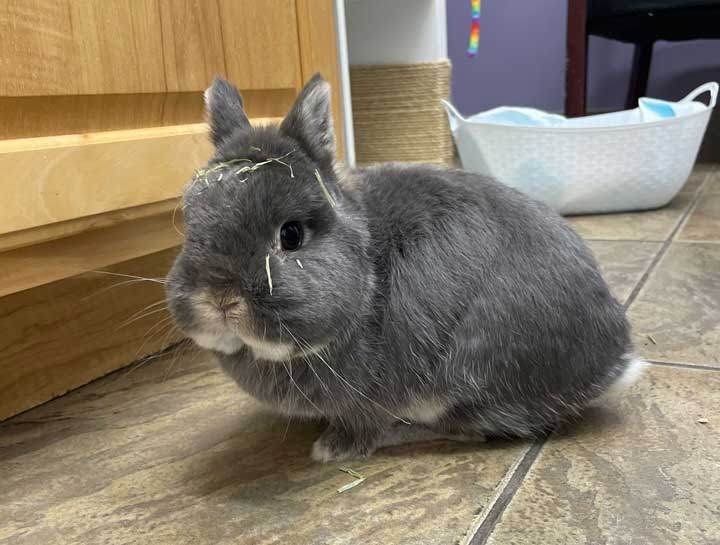Pocket Pet Care
Services for nontraditional pets.
Our small animal hospital in Acton provides care for various pocket pets and nontraditional pets including guinea pigs, rats, hamsters, and rabbits.
Whether you want to discuss how you can create a comfortable habitat for your pets or you have questions about what to feed them, we’re here to help.
We offer preventive care, nutritional advice, and general care recommendations for the following pocket pets:
- Guinea pigs
- Rats
- Rabbits
Why Should Bunnies Have Regular Health Exams?
Many bunny owners have experienced a time when their bunny was not eating well, scratching at an ear, sneezing, or had a strange scaling patch of skin and required a trip to their veterinarian. But just like with cats and dogs, regular health exams are vital to the prevention of many illnesses in rabbits. Let’s look at what’s involved in a rabbit checkup and why it’s so important:
- All our health exams start with an extensive history that dives into many aspects of rabbit husbandry and nutrition. These little guys may seem simple to care for but many of their illnesses are preventable. Diet is probably the single most important factor in maintaining their health. Rabbits are adapted, in terms of their teeth and digestive tract, to eating a diet high in fiber, low in fat, and low in starchy carbohydrates. Bunnies love their food but if they are fed the wrong things, serious digestive problems develop. Cage flooring and bedding, mostly in terms of ease of cleaning, can predispose to foot infections (pododermatitis) and respiratory infections.
- We track weight to monitor for any concerning changes that may indicate a chronic health condition. Weight loss may be the first indicator of dental or organ disease. Obesity, which is common in pet rabbits, can place strain on arthritic joints and predispose to pododermatitis.
- We do a full head-to-toe exam. Rabbits, especially floppy-eared breeds, are prone to ear infections that we may not be able to detect unless we look down the canal with an otoscope. It’s important to evaluate their teeth to look for elongated molars, spurs, and signs of infection or excessive salvation that could indicate oral pain. Rabbit’s molars are very small so we use a special tool with a magnifying camera to assess them.
- We discuss any behavioural concerns such as aggression, poor litter box habits, changes in activity level, and difficulties with bonding with other rabbits.
- We can perform wellness blood work to evaluate organ function and detect diseases in the early stages. It also gives us a baseline to refer to during periods of illness.
- We finish off our exam with a lovely and relaxing pedicure (aka nail trim)
Gastrointestinal Stasis in Rabbits
The most common reason for bunny visits to our hospital is a decline in appetite. After a thorough history and physical exam, gastric stasis is typically identified. Gastric stasis is not a diagnosis and is secondary to something such as stress, pain, or organ disease but it can be tricky to identify what the actual reason behind the appetite change is. Intestinal obstruction can at first appear to be gastric stasis, and even though both are dangerous, intestinal obstruction can cause death very quickly. Because rabbits are prey animals, they will appear stoic when sick or stressed, making it hard to evaluate how sick they are.
Let’s look at intestinal obstruction first and then review all the possible causes of gastric stasis. Rabbits groom regularly and will ingest a large amount of hair daily. Years ago, whenever we examined a rabbit with gastric stasis, we would identify a large amount of hair in the stomach and thought this was the cause of their signs. The presence of this hair is secondary to the slowing down of the digestive tract and not the problem, but hairballs can become impacted within the small intestines as the diameter decreases in size which is a problem. Furthermore, rabbits love to chew things like bedding and carpet which can also cause an impact. A rabbit can stop eating and experience a decrease in bowel movements with either gastrointestinal stasis or with an intestinal obstruction however, they will appear much sicker with an obstruction. It’s important that bunny owners not force feeding for an extended period if their bunny stops eating and appears lethargic. The additional food to an obstructed digestive tract can cause death.
On physical exam, these rabbits are usually very depressed, have abdominal pain, and will be hypothermic. When we assess blood work, they will usually have very high blood sugar. Lastly, abdominal X-rays will show a distended, fluid, and gas-filled stomach. We may also see large, gas-distended intestines. Treatment needs to be aggressive and includes pain management, intravenous fluids, and close monitoring in the hospital. The hope is that the impaction will pass but surgery may be required and carries a high risk.
The most common reasons we see gastric stasis in a rabbit include poor nutrition, stressful events, and dental disease. Rabbits require a diet high in fiber, low in fat, and low in starchy carbohydrates. Grasses or hay provide a balanced source of protein, digestible and indigestible fibers, vitamins, and minerals. Fiber stimulates the digestive tract and helps to wear down their teeth which are continually growing. This should be the bulk of a rabbit’s diet, but unfortunately, it can be difficult to persuade a rabbit to eat a new food item once they become accustomed to a particular diet, which highlights why it is so important to start with good nutrition habits from a young age. A bunny with bad nutrition habits will be prone to repeated bouts of gastric stasis.
Treatment of gastric stasis consists of first trying to identify the underlying cause which can sometimes remain a mystery. If the bunny appears stable and we are confident that there is not an obstruction, we give fluids to address any dehydration and send home with pain control and a high-fiber, nutritious supplement called Critical Care that is fed 3-4 times daily. We can also use a medication that hopefully will stimulate movement of the intestinal tract. Owners can encourage some exercise or rub their bellies to get things moving. Typically, improvement is seen in 1-2 days, but owners need to watch closely. If their bunny becomes more lethargic, bowel movements decrease further or they seem more painful which is seen as a hunched posture, grinding of teeth, and increase in breathing rate, this is an emergency, and they need to be seen by a veterinarian immediately. Once a bunny allows us to see they are visibly sick, they are critical.
Because inadequate nutrition is a common cause of gastric stasis, let’s review what a bunny should eat. Good nutrition should consist mostly of hay or grasses. Some bunnies like coarser hay while others may prefer softer grasses, and ideally it needs to be fresh. Hay from the pet store can sometimes be old by the time it’s purchased which can be a factor in hay refusal. Hay should be placed near where a bunny spends most of their time which is typically their litter box. To entice ingestion of hay, items can be mixed into hay such as some greens, or spritzed with fruit juices. Pellets should be timothy-based with no seeds or cereals. They may look boring to us, but bunnies love their pellets so don’t be surprised when they pounce on them before you can even set them down. We need to be careful they don’t overdo it and then have no room for their hay. An average 5 lb bunny should receive ¼ cup twice daily. If a bunny owner is feeding more than the ideal amount, they should slowly decrease the amount over weeks. Greens should be introduced one at a time to ensure there is no stomach upset and up to 2 cups daily can be given. Last is the sweets; sugary foods such as carrots and fruit should be given in very small amounts a few times weekly. When deciding on portion size, consider the size of the bunny. If a bunny is given a full carrot that is half the size of them, that is like us eating a pie half the size of our arm span. Who wouldn’t get stomach upset eating all that pie!
Additional services our small animal veterinarians offer include routine care, sick and injured care, tooth and nail trims, and surgery.
If you have questions about how we can help you best care for your pocket pet, call us at (519) 929-9308 to schedule a consultation.

